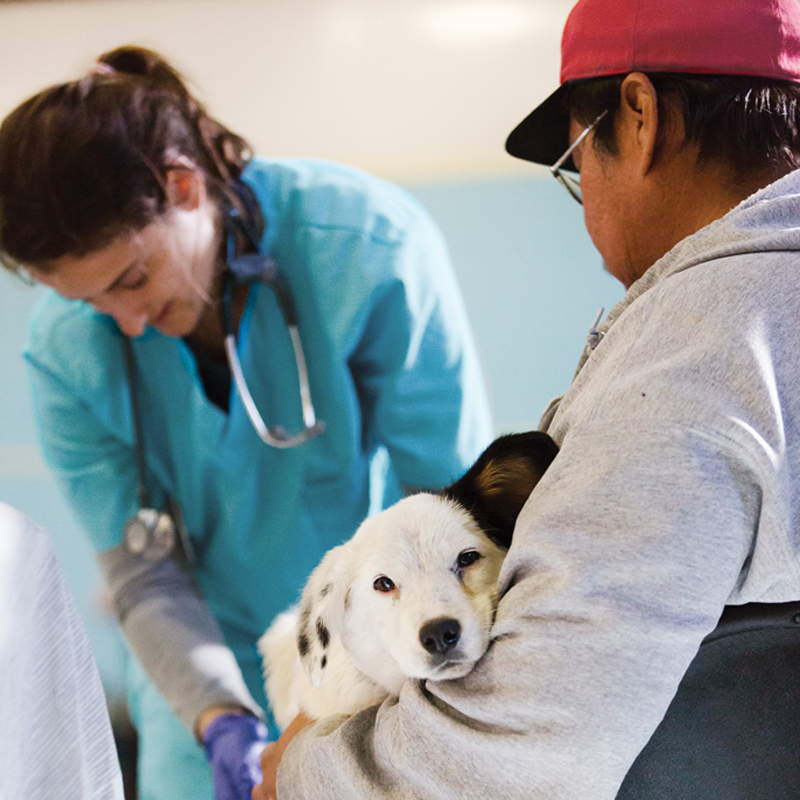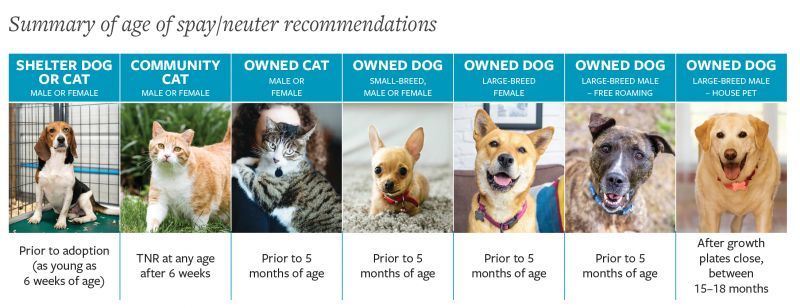Deconstructing the spay/neuter debate
How can we address concerns about the health impacts of sterilization?

After graduating from veterinary school in 1972, I completed a yearlong internship at the Henry Bergh Memorial Hospital in New York City. During that year, 132,000 dogs and cats were euthanized by the nonprofit contracted to handle animal control for the city. That number never left me, and the issue of pet overpopulation was indelibly imprinted in my mind.
In the decades that followed, the animal welfare field developed public information campaigns on the health and behavioral benefits of spay/neuter, pioneered protocols for pediatric surgeries and made spay/ neuter before adoption a standard (and in most states, legally required) practice among animal shelters across the country. And we’ve seen euthanasia numbers in this country plummet as a result.
For people in our field, the benefits of sterilizing cats and dogs are manifest.
But in recent years, the health benefits of sterilization for dogs and cats have been challenged. Four studies out of the University of California–Davis veterinary school have led some veterinarians to question early-age spay/neuter—or opt not to perform spay/neuter at all—and these doubts have trickled down to the public.
At one end of the spectrum, we have veterinarians arguing that we should delay performing these surgeries, or abandon them altogether, based on concerns over the incidence of certain orthopedic conditions and cancers. At the other end, we have veterinarians who promote early-age or pediatric spay/neuter based on concerns over other cancers, longevity and pet overpopulation.
Who is correct? And how can we, as veterinarians and animal welfare professionals, best care for the animals in our charge and address the confusion among pet owners faced with mixed messages?
When pet owners hear that spay/neuter is associated with an increased risk of disease, they’re understandably alarmed.
Examining the research
When pet owners hear that spay/neuter is associated with an increased risk of a particular disease, they’re understandably alarmed. A 2019 Washington Post article, “The growing debate over spaying and neutering dogs,” describes an owner’s decision not to neuter her two dogs, even though she has no plans to breed them. “Research that suggests neutering could be linked to cancers and joint disorders persuaded her that skipping sterilization was best for her pets,” the author writes.
What’s too often missing from the discussion is that spay/neuter decisions shouldn’t be based on the impact on a small handful of diseases. Instead, we must look at the overall health and longevity of the animal. And where research seems to point to a potential increase in occurrence of a particular disease, we must consider disease incidence and be prepared to explain why a decreased incidence of a common disease outweighs the potential increased risk of a rare one.
What’s too often missing from the discussion is that spay/ neuter decisions shouldn’t be based on the impact on a small handful of diseases.
Much of the spay/neuter research consists of reviews of medical records attempting to determine the incidence of various conditions compared with sterilization status and age of sterilization. Such studies show associations but can’t determine cause and effect. That means there is still a lot we don’t know and that spay/neuter decisions must be based on incomplete information.
In the UC Davis studies—“Golden retriever study” (2013), “Comparison of Labrador retrievers with golden retrievers” (2014), “Neutering of German shepherd dogs” (2015) and “Gonadectomy effects on the risk of immune disorders” (2016)—researchers reviewed veterinary records from a referral veterinary hospital to examine the incidence of joint problems (cranial cruciate ligament rupture and hip dysplasia), various cancers (lymphoma, hemangiosarcoma, osteosarcoma, mast cell tumors) and immune disorders. They reported varying degrees of increase in incidence of certain orthopedic, neoplastic and immune conditions in sterilized dogs.
Close examination of these papers, however, should cast doubt on the assumption that we should avoid or delay spay/neuter. The issues with these articles include:
- Lack of control variables: In the best research, everything is controlled except the factor you are studying. In studies reviewing past medical records, variables aren’t controlled. We don’t know the impact of diet, lifestyle, environment, preventive care, genetics or other factors on the outcomes in these studies.
- Biased research population: At referral institutions, cases managed by primary care veterinary clinics aren’t represented. The private practitioner might manage the dog with mammary neoplasia, pyometra or testicular cancer, but refer the case of osteosarcoma, hemangiosarcoma or lymphoma. This would skew the results, making some conditions appear less frequent and others more frequent. It gets even more confusing. What if animals are sterilized because they have an orthopedic condition or conformation that predisposes to an orthopedic condition as opposed to having an orthopedic condition because they were sterilized? Another factor that potentially skews the research results is the fact that a primary reason people don’t sterilize their dogs and cats is that they can’t afford the surgery. If someone can’t afford the cost of a spay or castration, what are the odds of them taking their pet to a referral hospital for specialized care?
- Extrapolation from one breed to another or one species to another: If all the findings in the UC Davis studies eventually prove to be true, breed differences confirm that you can’t extrapolate from one breed to another and certainly not from one species to another. The UC Davis authors point that out, but many in the public or in the profession seem to ignore that fact.
The value of the UC Davis studies is that they point to the need for more research—studies in which case criteria and data collection standards are defined in advance and consistently applied. They do not, however, justify wholesale changes in spay/neuter decision-making.

Looking at the big picture
The veterinary literature documents advantages and disadvantages to sterilization of dogs and cats. There is evidence that sterilization is associated with an increase in certain cancers and orthopedic conditions in some breeds of dogs, more commonly large breeds. There is also evidence that sterilization, especially early-age sterilization, significantly reduces the incidence of mammary neoplasia in female dogs and cats and that sterilized dogs and cats consistently live longer than intact ones.
A 2013 study at the University of Georgia analyzing the records of over 70,000 patients found that the mean age of death of intact dogs was 7.9 years, compared to 9.4 years for sterilized dogs. Sterilization was associated with a 13.8% increased life expectancy in male dogs and 26.3% in female dogs.
Sterilization was associated with a decreased risk of death from some causes, such as infectious disease; it was associated with an increased risk of death from others, such as cancer. Sterilized dogs were “dramatically” less likely to die from infectious disease, trauma, vascular disease and degenerative disease and more likely to die from neoplasia and immune-mediated disease. Within the neoplasia category, occurrence of transitional cell carcinoma, osteosarcoma, lymphoma and mast cell tumors was increased in sterilized dogs while the occurrence of mammary cancer was significantly decreased.
Sexually intact dogs and cats have seven times the risk of developing mammary gland neoplasms, compared with spayed dogs and cats.
In interpreting what appears to be conflicting information in the literature, keep in mind that recognizing that something may change the incidence of a condition is of little value without knowing the incidence. Significantly increasing the incidence of a tumor that is relatively rare still leaves that tumor relatively rare, while significantly decreasing the incidence of a tumor that is common may make that tumor uncommon.
Data from Banfield, which operates over 1,000 veterinary hospitals with a shared computerized medical record system, provides further evidence of an increased lifespan for sterilized pets. In 2013, Banfield released a report based on an analysis of data from 2.2 million dogs and 460,000 cats. Looking at longevity compared to spay/neuter status, researchers discovered that spayed dogs lived 23% longer than intact dogs, and neutered dogs lived 18% longer. For cats, the data showed a 39% increase for spayed females and a whopping 62% increase for neutered males.
What can we conclude so far?
- Sterilized dogs and cats live longer than intact dog and cats.
- Sterilized dogs have a higher incidence of certain rare cancers, immune diseases and, in some breeds, orthopedic conditions, but a lower incidence of more common diseases such as mammary cancer or pyometra.
- Intact dogs are more likely to die of infections and trauma.
Weighing unequal risks
If we could see into the future, we could determine which animals were going to develop osteosarcoma if they were sterilized and which were going to develop mammary neoplasia or pyometra if they were not. We could then make the best decision for each animal. Lacking that ability, we must make our recommendations based on population dynamics.

In the U.S., approximately 80% of owned adult female dogs are spayed. The incidence of canine mammary neoplasia is 4%, but that is almost exclusively in intact dogs. If the 4% of dogs with mammary neoplasia come primarily from the 20% of female dogs who are intact, the incidence of mammary neoplasia in intact dogs is nearly 20%, 100 times the incidence of osteosarcoma at 0.2%. Some articles claim that sterilization doubles the risk of osteosarcoma. But again, if 80% of dogs in the U.S. are sterilized, that “doubling” effect is essentially already represented in the 0.2% statistic.
In her 2007 article “Determining the optimal age for gonadectomy of dogs and cats,” Dr. Margaret Root-Kustritz summarized the literature up to that date, comparing disease incidences between sterilized and intact pets. If you total the reported incidence of all the conditions listed in Kustritz’s article that are considered serious or moderately serious and in which the incidence is increased in sterilized dogs, the total is 3%. The chances of a sterilized dog getting any one of these conditions is 3% versus the chances of an intact female dog getting mammary neoplasia at 20% or pyometra at 24%.
When it comes to pediatric spay/neuter, studies from Texas A&M and Cornell universities have concluded that there were no serious long-term medical or behavioral effects associated with early-age sterilization in dogs and cats. (For kittens who test positive for feline leukemia, it may be wise to delay surgery until 4-5 months to allow more complete development of the kitten’s immune system.)
Studies in 1981 and 2005 documented a significantly lower incidence of mammary neoplasia in cats when spayed prior to their first heat cycle. Given that median survival of cats with mammary neoplasia is generally less than one year and that up to 96% of mammary tumors in cats are malignant, the reduction in incidence of mammary neoplasia is very significant.
A 1997 study documented fewer anesthesia and surgical complications in cats sterilized under 12 weeks of age when compared to those sterilized at or after 6 months of age. The theory that castrating male cats prior to sexual maturity makes the penis smaller and predisposes them to urinary tract obstruction has been proven to be false. In a 1996 study, Kustritz and Drs. Shirley and Gary Johnston demonstrated no difference in urethral diameters between cats castrated at 7 weeks, castrated at 7 months or left intact. None of the short- or long-term studies has shown an increased incidence of urinary obstruction in neutered male cats.
Applying research to individual cases
It is a proven fact that dogs and cats who are sterilized don’t reproduce. While that statement sounds a little obvious, the point is that sterilization programs over time do reduce shelter intake and dog and cat euthanasia. Furthermore, sterilized dogs and cats are more likely than intact dogs and cats to be adopted from shelters.

Decisions related to if and when to spay/ neuter must be based first on the life situation of the animal: Is he in a home or homeless? And secondly, they must be based on an assessment of all known relationships between reproductive status and health and longevity. For owned dogs, we must make an informed decision based on species, breed, intended use and current medical knowledge. For most breeds, the protective effect of spaying before the first heat cycle on mammary neoplasia far outweighs the potential risks associated with other cancers and orthopedic conditions.
With what we currently know, these are my recommendations, assuming the animal meets health and weight requirements:
- Shelter animals: Spay/neuter prior to adoption, as young as 6 weeks.
- Community cats: Trap-neuter-return at any age after 6 weeks.
- Owned cats: Spay or castrate before 5 months of age.
- Owned female dogs: Spay prior to 5 months of age.
- Owned large-breed male dogs who are house pets: Orthopedic concerns may outweigh all others; spay/neuter after growth stops between 15-18 months.
- Owned large-breed male dogs who are free-roaming: Population concerns may outweigh all others; spay/neuter prior to 5 months of age.
- Owned small-breed male dogs: No evidence at this time for orthopedic issues; castrate prior to sexual maturity at 5 months.
There is much we don’t know about the impact of spay/neuter. We must, therefore, always remain open to new information and, if need be, change our minds. At the same time, we must be willing to look critically at new information to determine if conclusions are valid based on the research data.








